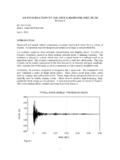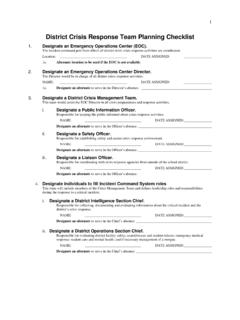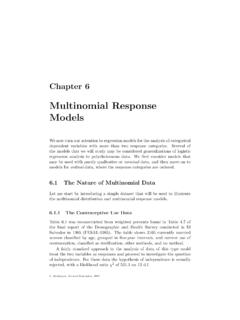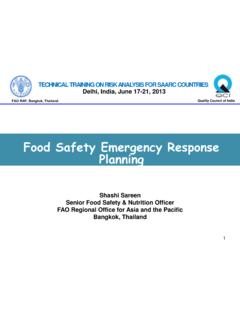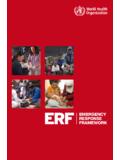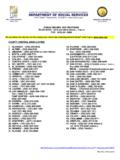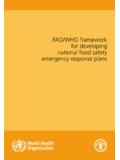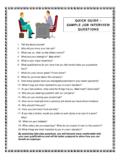Transcription of FDNY Fire Operations response on September 11
1 27 FDNY fire Operations response on September 11 This section of our report describes the major aspects of the response of FDNY fire Operations to the World Trade Center attack. It has four parts. The first describes how FDNY commanders exercised overall command and control of fire Operations at the scene. The second deals more specifically with how those commanders deployed and managed personnel and resources. The third describes how the fire Department handled planning of its resource requirements on September 11 and afterwards, and how the fire Department managed logistics ( , deployment of supplies and equipment). The fourth discusses the challenges faced by the Department as it sought to support and counsel its members and their families in the aftermath of September 11. COMMAND, CONTROL AND COMMUNICATIONS The FDNY s response to the attacks of September 11 began at 8:46 , the moment that American Airlines Flight 11 crashed into Tower 1 of the World Trade Center (WTC 1).
2 Command is established The Battalion Chief assigned to Battalion 1 (B1)10 witnessed the impact of the plane from the corner of Church and Lispenard Streets. He immediately signaled a second alarm11 and proceeded to the World Trade Center. En route, B1 requested additional resources by transmitting a third alarm at 8:48 B1 informed the FDNY Communications Office (Dispatch) that the corner of West and Vesey Streets, one block north of WTC 1, would be the designated staging area for third alarm B1 arrived at WTC 1 at approximately 8:50 As the first responding chief, he established the Incident Command Post 10 A battalion is a collection of FDNY resources or units ( , engine and ladder companies) responsible for a geographical area of the city. Four to five firefighters and one officer generally comprise a unit. Five to eight units comprise a battalion. Four to seven battalions comprise a division.
3 The World Trade Center was located in Battalion 1 s response area within Division 1. B1 and similar codes used in this document are radio designations. 11 Alarms correspond to the number and type of units deployed to an incident. A second alarm in a high-rise building typically deploys 19 pieces of apparatus and 11 chiefs. Third, fourth and fifth alarms deploy additional resources. 12 A staging area is a resource management area in close proximity to an incident. It is standard FDNY procedure to stage units assigned to third alarms and above. Units that are directed to stage are expected to respond to the staging area and await further deployment instructions. 28 (ICP) in the lobby, per FDNY s high-rise firefighting In approximately 10 minutes, from 8:50 to about 9:00 , Incident Command was established and passed (according to protocol) from B1 to the First Division Chief (D1) to the Citywide Tour Commander 4D (CWTC-4D)14 and finally to the Chief of Department (COD) (see Exhibit 2 for a command and control timeline).
4 At approximately 9:00 , the Incident Commander moved the Incident Command Post from the lobby of WTC 1 to the far side of West Street (an eight-lane highway) opposite WTC 1, because of the increasing risk from falling debris within and around the lobby and other safety concerns. Chief officers considered a limited, localized collapse of the towers possible, but did not think that they would collapse entirely. The command post in the lobby of WTC 1 became the Operations Post15 (OP-1) for WTC 1, reporting to the ICP. This Operations Post was managed by senior chiefs and was responsible for all Operations in WTC 1, including the assignment of units to search and rescue Operations in that building. It was necessary for the chiefs to remain in the lobby so they would have direct access to important building systems, such as controls for alarms, elevators, and communications systems.
5 The Field Communications Unit (Field Com) set up Operations at the West Street ICP at approximately 9:15 , in accordance with protocols. This unit was responsible for tracking the location and job assignment of all resources at the incident ( , which units responded to which alarms and which units were assigned to each tower). Field Com was also responsible for coordinating the assignment of additional units to the incident with Dispatch, upon request by the Incident Commander. Our interviews with the chief officers in charge of the Operations Post in WTC 1 indicated that, early in the response , they decided that Operations in WTC 1 should focus on search and rescue of injured and trapped civilians. The chiefs dispatched units from the lobby of WTC 1 to higher floors in two situations: In response to specific distress calls ( , people stranded in elevators, trapped in rooms, or hurt who would either call 911 or contact OP-1 directly through WTC 1 s internal telephone system).
6 To ensure that floors below the fire had been totally evacuated. 13 An Incident Command Post is the location from which all aspects of an incident, including Operations , logistics, and planning are managed. 14 The Citywide Tour Commander is a staff chief responsible for FDNY Operations throughout the city. One citywide tour commander is on duty at all times. On September 11, seven citywide tour commanders were designated CWTC-4A through H, except for the designation CWTC-4F, which was unused. 15 An Operations Post is where Operations are led for one component of the incident. 29 Units arriving at the lobby of WTC 1 checked in with the chief officers at the Operations Post for their assignments. Chief officers sent these units up into the building in a controlled, orderly way. Before 9:00 , D1 and B1 directed Port Authority personnel to evacuate surrounding buildings as a precautionary measure.
7 Plane hits WTC 2 At 9:03 , United Airlines Flight 175 hit World Trade Center Tower 2 (WTC 2). Resources were immediately deployed to WTC 2 from the West and Vesey staging area and WTC 1. CWTC-4B, in coordination with the Incident Commander and chiefs in command of OP-1, established an additional Operations Post in the lobby of WTC 2 (OP-2), reporting to the Incident Commander. As at WTC 1, we believe that chiefs sent units arriving at WTC 2 up into the building in a controlled, orderly way. Chiefs designate staging areas As the mobilization escalated, senior chiefs established staging areas near the World Trade Center. However, as units approached, many failed to report to these areas and instead proceeded directly to the tower lobbies or to other parts of the incident area (see Exhibit 3 for a staging timeline). For instance, early in the response B1 designated the corner of West and Vesey Streets as the staging area for third alarm units.
8 Starting at 8:53 , Dispatch sent radio instructions to these units to stage at West and Vesey. At 8:57 , the Chief of Department, while still en route to the incident, requested the assignment of a staging chief to coordinate activities at West and Vesey. He then issued a fifth alarm for WTC 1 and responding units were instructed to report to this staging area. At 9:12 , the Chief of Department issued a fifth alarm for WTC 2 and at approximately 9:16 , the corner of West and Albany Streets (two blocks south of the World Trade Center) was designated as the staging area for WTC 2. All units responding to that fifth alarm were directed by Dispatch to stage there. Citywide Tour Commander CWTC 4E assumed command of that area as the staging chief. However, it is unclear whether all units received Dispatch s radio transmissions instructing them to stage because the units were not explicitly asked to confirm receipt of the transmission and they did not acknowledge the messages.
9 Some 30 units responding to WTC 2 from Brooklyn may have been in the Brooklyn-Battery Tunnel, out of the reach of the Dispatch s radio communication and Mobile Data Terminal16 (MDT) systems, when the staging directions were transmitted. As units converged on the scene and civilians were evacuated, there was traffic congestion and gridlock in the area. Several units traveling from the north had difficulty getting to their staging area south of the towers. Our interviews and reviews of dispatch tapes suggest that several responding units were unable to reach their staging areas with their apparatus and therefore proceeded on foot directly to the tower lobbies. Among those units that failed to report to the West and Albany staging area were those responding to the fifth alarm for WTC 2. Interviews indicated that several units (probably including those responding to this fifth alarm) traveled past this staging area on their apparatus.
10 After waiting approximately 23 minutes for adequate resources to arrive at the West and Albany staging area, CWTC-4E issued an additional second alarm for WTC 2. Units responding to this additional second alarm did report to the staging area. At 9:47 , the Incident Commander requested additional resources and issued a third fifth alarm for the incident. Units were directed to respond to the West and Vesey staging area. The lack of staging had several effects. Chief officers on the scene, the Field Communications Unit, and Dispatch could not accurately track the whereabouts of all units. Units that failed to stage may have not received necessary information and orientation before going into the towers. As a result, several companies that were not from surrounding battalions had problems differentiating WTC 1 from WTC 2. Interviews with chief officers in command of the WTC 1 Operations Post indicated that several units that arrived there asked for confirmation of whether they were in the lobby of WTC 1 or WTC 2.











